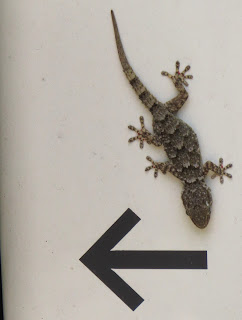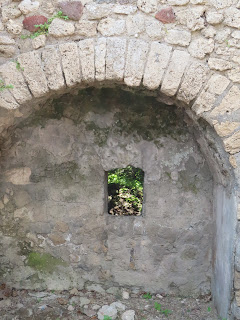Destroyed in a huge volcanic eruption in 79 CE, Pompei has slowly been re-emerging from the layer of ash for the last 250 years. accidental discoveries of the town were first recorded in 1594 and by 1600 traces of buildings and coins had been uncovered. These efforts came to a halt in 1631 after a strong earthquake. Larger, albeit haphazard, excavations were ordered by King Charles III of the house of Bourbon (Spain) in 1749 and in 1765. It was not until after the unification of Italy that the site was split up into grids and the excavations were carried out scientifically and systematically. We were smart and already had our tickets, thus saving ourselves a half hour line at the ticket booth. We did some wandering about and got lost many times. That is the fun of the "megandering principle" meander about but all the while taking a gender at all the surroundings.
Taking the inter city train we passed Salerno's port
Large viaducts
Picture windows
Vesuvius
The Pompei train station
We got into a cab
A shared cab
Lots of folks
Serious reconstruction
Gecko!
We followed the crowd, not to the entrance but to the exit!
We were listening to the Rick Steves audio guide but it was not matching up
Lots to see at this end of the park
The poppies were beautiful
Heading back to the entrance and we see many workers busy rebuilding
Now we entered the old city gate
Rick Steves is telling us what is what
The basilica, not a church but a administrative center
The forum, the main square
Columns to spare
The Romans pioneered the use of fired bricks
Some columns were marble but many were brick with a plaster facade
The plaster make the columns look like marble
Built to last
These are marble
Mount Vesuvius
The brick is showing
No signs of volcanic activity
It is a busy place
The grainery
Shops were on the ground level and grain was stored above the shops
As the ash and pumice was being removed hollow spots were identified and plaster poured into the void left behind by the person that was buried int heh ash
Some were praying
Some seem to be in agony
The detail is astounding
Still painted frescos on the walls
Gates up to keep some areas off limits
A place for a statue
Bones of the merchants trapped in their shops
Heading along the main street
To the baths
Still decorated
Arched ceilings
The workout area outside in the courtyard
Work up a sweat
Get a massage
Slaves did the massaging, then into the tepidarium
It was cooler inside, time for the hot baths
Under watchful eyes
These are where small stoves were used to cook food
It was the Roman version of fast food
Some walls survived better than others
Looking into a large house
The ruts in the stone were from the carts
Deep grooves
The larger stones were stepping stones so folks could cross the road without walking on them
The interior of the houses would have a central opening int he roof both allow light in the house but also rainwater would come in and be collected in this marble pool
More poppies
Beware of the dog mosaic
Public fountains were everywhere
Amazing how many carts had to travel on this road to wear the rocks down?
20,000 people liven in this town
Lookin in to the inside of another house
Getting deep into the ruins
Arches and openings
And flowers
Grooves at the doorways for folding doors
A window or a place for smoke to escape
Smokers trashing the place
Grist mills for grinding grain
A hole in the roof
And the area to collect rainwater









































































